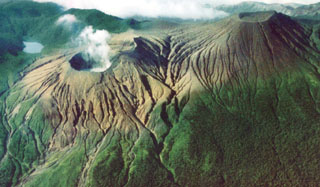Report on Rincon de la Vieja (Costa Rica) — April 1991
Bulletin of the Global Volcanism Network, vol. 16, no. 4 (April 1991)
Managing Editor: Lindsay McClelland.
Rincon de la Vieja (Costa Rica) Ash ejection and lahars
Please cite this report as:
Global Volcanism Program, 1991. Report on Rincon de la Vieja (Costa Rica) (McClelland, L., ed.). Bulletin of the Global Volcanism Network, 16:4. Smithsonian Institution. https://doi.org/10.5479/si.GVP.BGVN199104-345020
Rincon de la Vieja
Costa Rica
10.83°N, 85.324°W; summit elev. 1916 m
All times are local (unless otherwise noted)
A [phreatomagmatic] eruption at 1015-1025 on 8 May ejected small quantities of [ash, bombs, blocks, and mud, and produced small lahars]. Gray lahars with a sulfur odor traveled N down the Río Pénjamo and Azul systems, destroying the forest along the rivers and two small bridges, and cutting off access to the towns of Buenos Aires (12 km NE) and Gavilán. At the distal end of the lahars, 15 km from the summit, the deposits reached 2 m in thickness, and covered the surface for several hundred meters on both sides of the Pénjamo river channels. Following passage of the lahars, the rivers were milky and had high acidity. The eruption followed two smaller explosive events on 6 and 7 May, but no other seismic precursors were recorded.
Geological Summary. Rincón de la Vieja, the largest volcano in NW Costa Rica, is a remote volcanic complex in the Guanacaste Range. The volcano consists of an elongated, arcuate NW-SE-trending ridge constructed within the 15-km-wide early Pleistocene Guachipelín caldera, whose rim is exposed on the south side. Sometimes known as the "Colossus of Guanacaste," it has an estimated volume of 130 km3 and contains at least nine major eruptive centers. Activity has migrated to the SE, where the youngest-looking craters are located. The twin cone of Santa María volcano, the highest peak of the complex, is located at the eastern end of a smaller, 5-km-wide caldera and has a 500-m-wide crater. A Plinian eruption producing the 0.25 km3 Río Blanca tephra about 3,500 years ago was the last major magmatic eruption. All subsequent eruptions, including numerous historical eruptions possibly dating back to the 16th century, have been from the prominent active crater containing a 500-m-wide acid lake located ENE of Von Seebach crater.
Information Contacts: R. Barquero, ICE; J. Barquero and R. Sáenz, OVSICORI.

